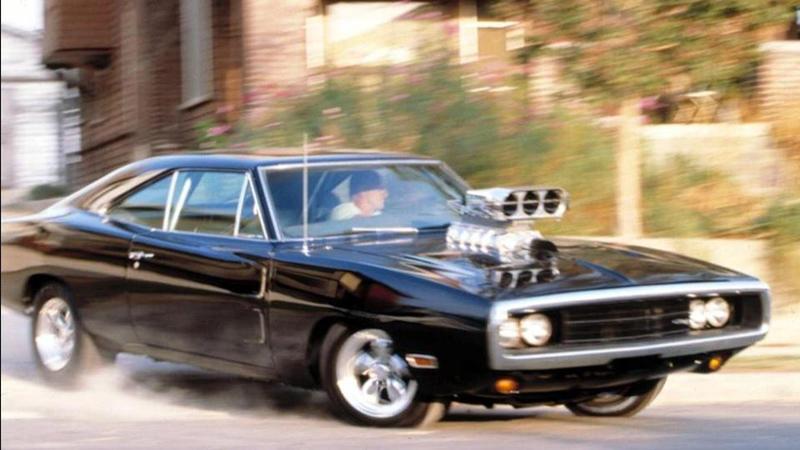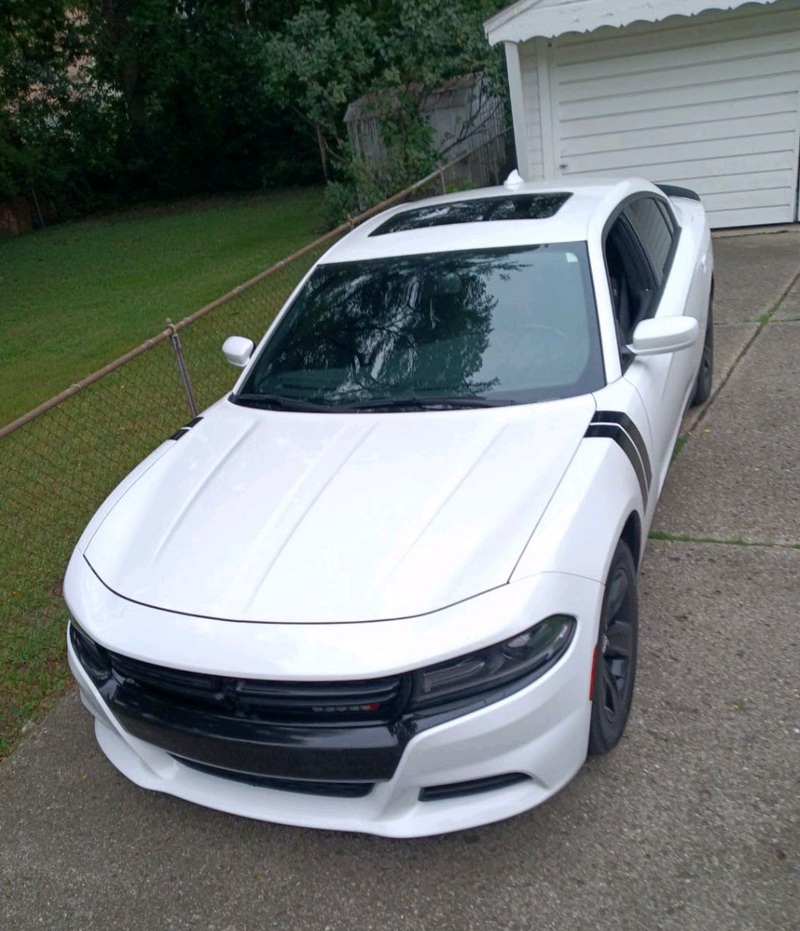When it comes to automotive misbehavior in Metro Detroit, one make and model reigns supreme: The Dodge Charger (or its two-door sibling, the Challenger.) At least at the moment. Eavesdrop on some elderly hood-poppers at the Dream Cruise and you’ll hear stories of other preferred rides of the devoted knucklehead-in-the-driver’s-seat of yesteryear: GTOs, Firebirds, Mustangs.
But these days, when you’re passed on the freeway on a summer night by a squadron of speeding muscle cars, flying in formation on a mission of mischief, you’re likely to be looking at the taillights of a Dodge.
A high-speed (130 mph) chase that ends when the fleeing car runs out of gas? A Charger. Another high-speed chase with two other vehicles hit? Charger. Grandma's house hit? Charger. One-car double fatal? Charger. A spinout into a restaurant's front windows? Charger.
And who could forget the "We on the Lodge wit' it" incident, which birthed a million memes, a Gmac Cash song, a T-shirt and a legend. Chargers, Chargers and more Chargers.

Rick Lawrence's show-car Charger has some modifications (Photos: Nancy Derringer)
Why Dodge, and why now?
“They’re the cheapest rear-wheel drive muscle car you can find,” said John Pearley Huffman, contributing editor for Road & Track magazine. (Rear-wheel drive is essential for drifting – the tire-burning donuts that draw crowds when done in “sideshows,” but also, in one memorable case, around two Detroit Police vehicles in the middle of Gratiot, as onlookers recorded it all with smartphones.) Chargers also go fast in a straight line, and the more horsepower you add, the higher the price tag climbs, until it tops out in the high five figures, or beyond, depending on customization.
Chargers have higher-end options that almost encourage misbehavior, because what’s the point of having nearly 800 horses under the hood if you can’t let ‘em gallop from time to time? There’s line lock, which allows the driver to lock the front and rear brakes independently, so you can get the rear wheels spinning like crazy, then release the front and launch the car, exactly like a drag racer. Data collected onboard will tell you how the ferociously fast 0-60 you just pulled compares with the one you did yesterday.
“It’s a street-legal racecar, basically,” said Thad Szott, co-owner of Szott Auto Group in White Lake Township. “You can be cruising on the highway at a pretty good speed, put the pedal down and it’ll throw you back in your seat. For that kind of production vehicle with that kind of horsepower, $85,000-$100,000 is actually a pretty good value.”
Chargers of any kind, but particularly the higher-horsepower models, are in extremely high demand on both the legal and illegal markets, a fact Szott knows from both sides. His dealership made the evening news last October, when thieves stole four Dodge models off the lot, one for the second time. All four were recovered, but it was a reminder, as if he needed another one, that no Charger is ever truly safe from those who would covet it.
Related:
The one that was stolen twice had been damaged in the first attempt. The parts to repair it took months to arrive, and the job had just been finished, the car parked inside for safekeeping until it could be picked up. Ha ha: Thieves drove it right through the dealership’s plate-glass window.
Szott’s crew have a strict policy on Chargers and Challengers now. They are disabled as soon as they hit the ground off the car carrier; “the car won’t start, the car won’t drive,” said Szott, who added he even has misgivings about advertising them, because “it’s like giving thieves a shopping list.”
It should be noted, for the sake of accuracy, that not all four vehicles stolen that night in October were Chargers. One was a Ram pickup, another a Durango SUV, both with 700-horsepower Hellcat motors. Which raises the question: Does anyone need that kind of power in a pickup truck?

Not a stock dashboard, but a cool one
“You don’t, but you can,” replied Szott. “And this is America.”
The original bad boys
This is, indeed, America. The founders of the Dodge brand, brothers Horace and John, were known as hot-tempered brawlers who liked to drink and knock heads. And while they had enough money to crash any party in town, they weren’t invited to all of them. An article posted on the Hagerty Co. website notes, “When the Grosse Pointe Country Club wouldn’t admit him, Horace built an enormous mansion on the adjacent property, with a 12-car garage facing the country club in order to make as much noise as possible.”
It’s almost as if these cars, a century later, carry their DNA.
And the company does its share to keep the models’ reputation just this side of respectable. Huffman notes that Dodge pays for product placement in the “Fast and Furious” movie franchise; maybe you’ll remember the sequence in “Fast Five,” where actors Vin Diesel and Paul Walker tow a bank vault like a water skier through the streets of Rio de Janeiro, driving twin matte-black Chargers.
The Fast and Furious movies, a franchise that already encompasses nine films with no signs of slowing down, are useful for understanding the appeal of not just Chargers, but muscle cars in general. They’re in the mold of targeted-enthusiast films through the decades, which is to say the stories and acting are tissue-thin, and serve mainly as filler between action sequences, which all involve cars. The longer the series goes on, the more ridiculous these wham-o scenes get, the less constrained they are by physics and law enforcement and other boring concepts.
A vintage 1970 Charger – with a hole cut in the hood for its supercharger to poke out of, because this car’s engine is so monster it cannot be contained in even a cavernous ‘70s-era compartment, perhaps – is the star of the final action sequence in the very first film, which tells you something. It’s canon, as the academics say. Let’s let Vin Diesel, in his role as Dom Toretto, introduce the car he built with his late father:
Me and my dad built her. Nine hundred horses of Detroit muscle. It’s a beast. Know what she ran in Palmdale? Nine seconds flat. My dad was driving. So much torque, the chassis twisted coming off the line. Barely kept her on the track.

Stand back, it's the Fast-and-Furious '70 Charger (Photo: Universal Studios)
(Is that even possible? To twist a chassis coming off the line? Whatever. You have to suspend a lot of disbelief to watch these films. Again, from the Hagerty website: In the saga’s next entry The Fate of the Furious, Dom pursues a submarine in Russia in the Ice Charger, a ’68 Charger with a rear engine, specifically a 550 horsepower LS motor. You know, because you want the weight over the drive wheels when you’re chasing a submarine. In a car.)
Anyway – spoilers ahead – that ‘70 Charger gets wrecked in the final action sequence, but like all fantasy characters, it has been resurrected multiple times, and joined by other Dodge brethren, many built just for the franchise, because the people who run this company know who their customers are.
At heart, a fun drive
Is this the point we should mention that Deadline Detroit asked the company to talk about Chargers as misbehavior models? Perhaps so. A spokesman answered the email almost immediately, respectfully declining to comment.
Auto journalists were more chatty.
Alanis King used to write for Jalopnik, and now writes for Business Insider. She adores Chargers, especially the Hellcats.
“The first time you get into a Hellcat it’s really freaky,” she said from her home in Texas. “You have all these expectations. This car is wild. You're almost scared to do anything with it.” Even at a stop, “the car is just growling under you. It feels like it’s gonna pounce.”
The joke, King said, is that “they’re not supposed to turn,” but she’s taken one out on a race track and found it surprisingly supple. However, she added, “I have a spot (pushing the accelerator) that my foot does not go past. That’s the spot where your back end gets squirrely. I have never gone all the way to the floor. I’m sure there are people who have done that, and I pray for them.”
Huffman, at Road & Track, is more blasé, noting the work Dodge does keeping the models relevant.
“The cultural zeitgeist migrates from car to car,” he said. “Dodge has had to work hard to keep it in the forefront of buyers’ minds. Until Covid, they were selling more Challengers every year. It’s a great-looking car. Camaro is going out of production, but that big Challenger just keeps on selling. People love the way it looks.”
Ask the man who owns one
Some data seems pertinent to mention: The average age of a Charger/Challenger owner is somewhere in the 50s. With some exceptions, these are people who have aged out of automotive mayhem, for the most part. They have concerns beyond drifting donuts around police cruisers. But they haven’t grown all the way up. Take Gary Supal, 57, of Redford.
“I’m a mechanic and have seen a lot of these cars that are wrecked,” he said. But “the cabs are never touched. They’re made really well.” A pause. “Plus, I like to race.”
Supal doesn’t race irresponsibly, he hastens to add. Never on surface streets – too dangerous. But on the freeway? When another hot car pulls up even, drivers’ eyes meet and a certain understanding passes between them? OK, then.

Gary Supal's beloved Charger (Courtesy photo)
But he does not drift. “My tires cost $300-$400 apiece,” he said. Case closed.
Even as a reasonably responsible owner, he admits his 2018 Charger SXT, purchase price around $40,000, has a hold on him that your own car probably doesn’t. It’s garaged when Supal isn’t driving or washing it, and he washes it so often his neighbors tease him that he will soon be rubbing the paint off. Its specs: Around 325 horsepower, but he’s ready to add a procharger, a type of supercharger, that will boost that to 500, he said.
“It goes well and handles well, and it can take a turn,” Supal added. As much as he loves it, though, there’s room in his heart for another. Were money no object, he admits, he’d absolutely trade his SXT for an RT, i.e., a Hellcat.
Rick Lawrence is the same, 46 years old and with a bit more skin in the game. He’s a union steward at Stellantis’ Sterling Heights Assembly Plant (which makes Ram pickups), and drives a Charger, although his devotion began before his professional association with the company; he’s among the probably thousands of young men who flipped for the General Lee, the orange ‘69 Charger driven by Bo and Luke Duke in the ‘80s TV series “The Dukes of Hazzard.” His dad was a Ford man, but the time father and son spent in the garage together cemented his love of fast cars.
Today he drives a 2019 Charger with the Scat Pack, the 392 cubic-inch V8 that he estimates is “pushing 475 horsepower” off the showroom floor. It’s a badass ride for sure, one he cherishes and babies. In fact, it’s a show car; he’s fond of after-market vinyl trim decoration, changes it often, and texts over several photos of his car dressed in different stick-on stripes, decals, wraps and other automotive makeup.
To ask Lawrence if he ever stunts with this beloved art object is an insult. The crazy ones, he said, are the ones who give guys like him a bad name and make him a cop magnet.
“I’m not trying to get no tickets,” he said. Not for him the Instagram boasting, hashtagged #TSNLS (turnt shit not lame shit). You want to take your Charger to a drag strip? That’s cool. But racing on city streets or blocking off freeways? Not for Lawrence.

Rick Lawrence and "392 Reasons," his current ride
“It makes me mad because I get stereotyped,” he said. “I have a (Chargers and Challengers) club, and I’m getting phone calls (after the Lodge incident), asking if that was you on the freeway. I got a grandbaby, I don’t do that crazy stuff. I’ve never done not one donut. Those tires are not cheap.”
Lawrence is a man, with a job, a mortgage and responsibilities, not to mention several different antitheft apps on his phone. The people who race, who drift, and who often wreck their rides doing so? They’re a different part of the family.
“This is a personal-responsibility question,” said Huffman, the auto journalist. “My personal opinion is that I enjoy powerful cars without being a knucklehead. I can enjoy a car without being a fool, and I’m glad they’re available. I can’t tell young people how to behave.”
When we were getting around on horses, people figured out a way to misbehave on horses.
One day, Huffman points out, we’ll all be driving autonomous cars. And the question then will be, he said, “How do I hack this? It’s the nature of humanity.
“I mean, they had the death penalty for dealing in the black market in the Soviet Union,” he said. “And it didn’t kill the black market.”
► Support our reporting by becoming a Deadline Detroit member for as little as $3 per month.


 by
by







